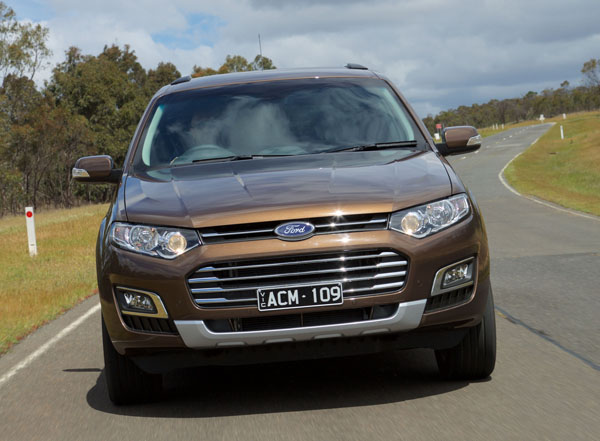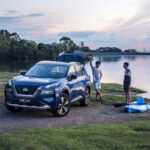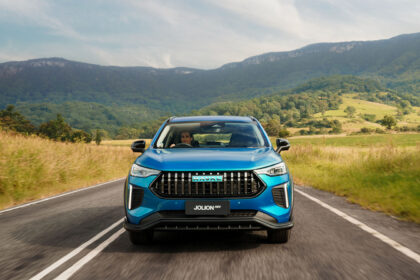Hanging on the coat-tails of the new Falcon FG X, is a refreshed Ford Territory SUV. And in line with the new-look sedan, the Territory SZ Mk II gains Ford’s advanced in-car connectivity system, SYNC2, standard across the range, as well as WiFi hotspot and voice control smart technology.
Three variants of Territory – TX, TS and Titanium – are on offer in either rear-wheel, or all-wheel drive, while the well-sorted 4-litre in-line six-cylinder petrol and 2.7-litre V6 TDCi engines carry over into the 2014 line-up.
Most importantly, prices have been cut across the board by up to as much as $6500. The entry-level Territory SZ Mk II TX rear-wheel drive petrol comes in at a manufacturer’s list price of $36,990, $3000 less than its predecessor, while the Titanium rear-drive petrol tips the scales at $48,490, down $6500.
Prestige paint, seven-seat capacity, tan leather seat trim and tow pack are variously standard or cost options across the range.
With more than 155,000 Territory SUVs sold across Australia, Ford has listened to its buyers and come up with an impressive list of additions to tempt them into upgrading their vehicles.
Titanium customers are wooed with new 18-inch alloy wheels, SYNC2 infotainment system, rain-sensing wipers, stainless steel scuff plates, front fog lamps and side steps. That’s on top of rear-seat roof-mounted DVD player and seven seats, standard features brought over from the previous model.
The TS receives a lift with features previously reserved for Titanium. These include privacy glass, exterior side mirrors with indicators and a new front fog lamp design. Once again new 18-inch alloy wheels, standard seven-seats and cloth seats with leather side bolsters carry over from the current TS.
Territory TX buyers are not forgotten, with new features including new 17-inch alloy wheels, an 8-inch colour touch screen with SYNC2 and range-spanning reversing camera with fixed and active guidelines.
On the outside, the latest Territory can be distinguished from the previous model by the Ford signature trapezoidal grille with contrasting horizontal bars, a rugged lower skid plate and large rectangular fog lamps with matching bezels.
Inside, the Ford Australia design team has built on the SUV’s renowned practicality, with five or seven-seat flexibility, user-friendly technology including improved instrument cluster graphics and new fabrics.
The premium feel of the top-of-the-line Titanium model is enhanced by the choice of a quality tan leather trim on the seats and door inserts, complemented with black carpeting.
As with all SUVs, storage space is a key consideration. Here the new Territory ticks all the boxes. At the base of the centre console and just ahead of the transmission gear shifter is a deeply recessed storage bin, ideal for mobile phones, iPods or small cameras.
Also, in the centre console bin is an integrated phone cradle with a convenient connection. And, for once, the recessed drinkholders are clear of the handbrake and automatic transmission shifter.
Everything appears to have been thought of, even a dedicated area for a tissue box, including an integrated pen holder and a 12-volt accessory outlet.
Star of the show, so to speak, is SYNC2, Ford’s advanced in-car connectivity system, with a new graphic display utilising layers and colours to aid navigation of menus and connected functions.
With a four-quadrant colour touch screen, it is designed to be easy to use, allowing occupants to adjust and personalise audio, climate, phone and various other settings of the in-car systems.
A traditional human-machine interface button and voice control allow access to entertainment system controls, climate control settings, phone information and satellite navigation with traffic message channel, the last on Titanium only.
Digital radio is standard on all Territory Mk II models, providing a high quality audio signal.
Passengers can also view more information, via the touch screen, of what the digital radio is playing. It shows the title and artist of the song, the news headlines, or the latest sports results depending on the broadcast.
To improve reception, the DAB+ radio includes a dual antenna system – in the roof and behind the front bumper, while WiFi capability creates a wireless network hotspot in the vehicle, allowing other devices such as personal computers or games to be operated.
On a drive as part of the media introduction was on bitumen in some not particularly testing terrain, a Territory petrol rear-wheel drive and diesel all-wheel drive, both in Titanium spec, adapted to any slight variation in road conditions, both producing a comfortable ride.
Handling was hardly tested, with body roll all but absent, even on the odd sharp bend. Both engines were particularly responsive and operated with little noise intruding into the cabin, making for ideal surroundings to hold a normal conversation.
Ford says it has been able to improve fuel efficiency on the petrol versions thanks to a new lightweight six-speed gearbox. The petrol SZ Territory Mk II TX officially achieves a 3.9 per cent improvement (10.6 L/100km to 10.2 L/100km) on the combined urban / highway cycle, while the Territory SZ Mk II TS and Titanium petrol models have improved 1 per cent (10.6 L/100km to 10.5 L/100km).
The combined fuel consumption figure for the 2.7-litre V6 turbo-diesel remains the same, at 8.2 L/100km (TX TS, Titanium RWD) and 8.8 L/100km (TX AWD) and 9.0 L/100km (TS and Titanium AWD).
The complete range of the new Ford Territory SZ Mark II is:
TX RWD petrol: $36,990
TX RWD diesel: $40,240
TX AWD diesel: $45,240
TS RWD petrol: $41,740
TS RWD diesel: $44,990
TS AWD diesel: $$49,990
Titanium RWD petrol: $48,490
Titanium RWD diesel: $51,740
Titanium AWD diesel: $56,740
Note: These prices do not include dealer or government charges. Contact your local Ford dealer for drive-away prices.











